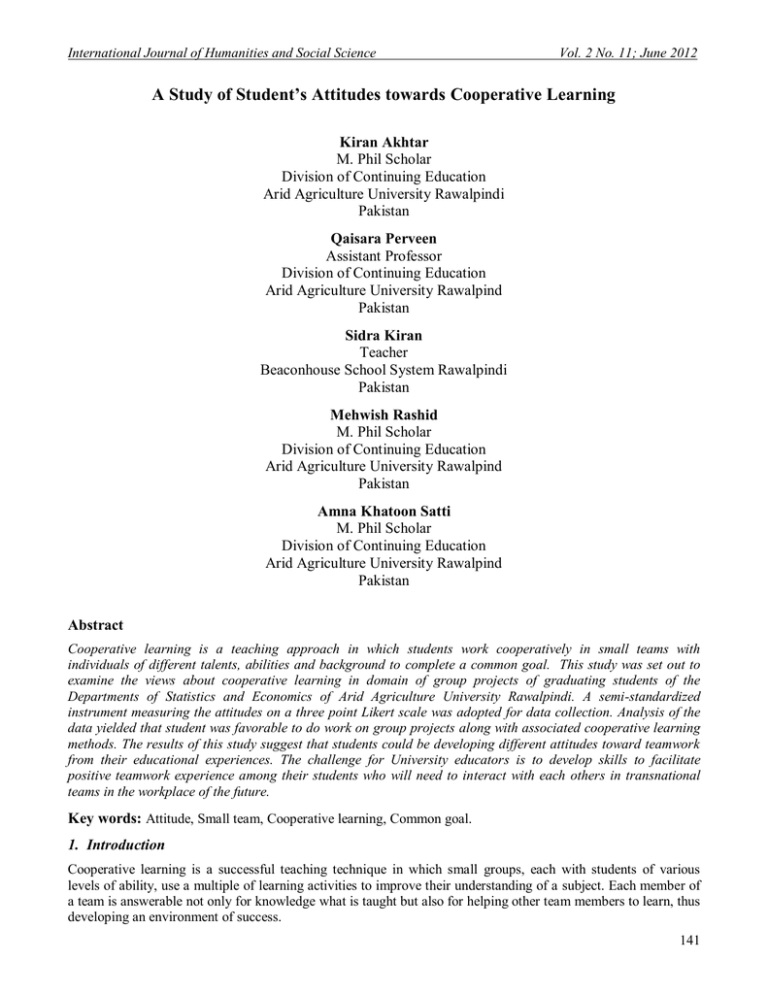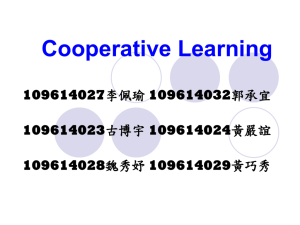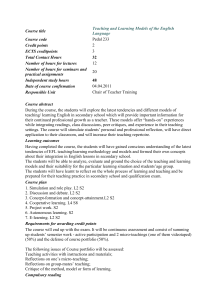Document 10464411
advertisement

International Journal of Humanities and Social Science Vol. 2 No. 11; June 2012 A Study of Student’s Attitudes towards Cooperative Learning Kiran Akhtar M. Phil Scholar Division of Continuing Education Arid Agriculture University Rawalpindi Pakistan Qaisara Perveen Assistant Professor Division of Continuing Education Arid Agriculture University Rawalpind Pakistan Sidra Kiran Teacher Beaconhouse School System Rawalpindi Pakistan Mehwish Rashid M. Phil Scholar Division of Continuing Education Arid Agriculture University Rawalpind Pakistan Amna Khatoon Satti M. Phil Scholar Division of Continuing Education Arid Agriculture University Rawalpind Pakistan Abstract Cooperative learning is a teaching approach in which students work cooperatively in small teams with individuals of different talents, abilities and background to complete a common goal. This study was set out to examine the views about cooperative learning in domain of group projects of graduating students of the Departments of Statistics and Economics of Arid Agriculture University Rawalpindi. A semi-standardized instrument measuring the attitudes on a three point Likert scale was adopted for data collection. Analysis of the data yielded that student was favorable to do work on group projects along with associated cooperative learning methods. The results of this study suggest that students could be developing different attitudes toward teamwork from their educational experiences. The challenge for University educators is to develop skills to facilitate positive teamwork experience among their students who will need to interact with each others in transnational teams in the workplace of the future. Key words: Attitude, Small team, Cooperative learning, Common goal. 1. Introduction Cooperative learning is a successful teaching technique in which small groups, each with students of various levels of ability, use a multiple of learning activities to improve their understanding of a subject. Each member of a team is answerable not only for knowledge what is taught but also for helping other team members to learn, thus developing an environment of success. 141 © Centre for Promoting Ideas, USA www.ijhssnet.com Students work from beginning to end the assignment until all group members successfully comprehend and complete it. They work in group to gain from each others efforts; they share a common fate, work in cooperation and feel proud for group success. Cooperative learning has group goals that create what is known as positive interdependence. Positive interdependence is when students believe they can reach their learning goals only when other students in their cooperative group also reach their goals (Johnson and Johnson, 1987). Positive interdependence means that individual accountability must occur. Cooperative groups work together to earn rewards, grades and recognition. There is consensus among cooperative learning reviewers that individual accountability and positive interdependence are actually essential components for successful cooperative learning (Slavin, 1989). The fact that group work could be used without individual accountability is controversial and may not be considered cooperative learning by some researchers. When there is not individual accountability and there is only one work product from the whole group, academic achievement may not occur for all students in the group. Unless there is equal distribution of responsibilities for learning, higher ability students may complete the work without the participation of others. Individual accountability and group goals contribute to academic achievement and teachers need to do individual assessments (Slavin, 1989). Group rewards as well as a schedule that has structure is essential to team learning (Slavin, 1978; Whicker, Nunnery and Bol, 1997). Group rewards encourages all students to participate because individual students are rewarded only when all members of the group are successful. Students cooperate together in teams and some methods of cooperative learning promote competition between the teams. This competitive structure presents a controversy. Structure and rewards, recognition and individual accountability are all important to the cooperative teaching model. Yet teachers that believe in the democratic principles of cooperative learning may not like how structured it is or the fact that group rewards are learning incentives. In view of Johnson and Johnson (1987) it is essential that students learn skills that will enable them to work cooperatively in groups. Students can’t be expected to know how to work collaboratively unless they have been taught these skills. Cooperative learning undertaken without explicit instruction to students regarding how to work with others collaboratively will not provide success (Johnson and Johnson, 1987). Research findings show that cooperative learning approach: sponsor student learning and educational attainment; amplify student maintenance; improve student satisfaction with their learning experience; help students develop skills in verbal statement; increase students' social skills; enhance student self-esteem; help to promote positive race relations. (Kagan, 1994). Cooperative learning is not only the group work. A basic difference between cooperative learning and traditional group work is that in classical group work, students are asked to work in groups with no attention compensated to group functioning, whereas in cooperative learning, group work is carefully organized, planned, and examine (Jacobs, 1997; Johnson & Johnson, 1994; Ng & Lee, 1996). Instructional models and structures have been designed, which teachers can adopt and adapt, to help the group work operate more successfully by creating an atmosphere for interactive learning (Abrami et al, 1995). Cooperative learning changed the theory of traditional methods of teaching. The traditional methods of teaching have insuffient to teach so there is need to integrate it with cooperative learning which is students centered approach use to change teaching learning environment for betterment of learners and their academic achievements. With this perspective, this descriptive study provides feed back of graduate students of Arid Agriculture university about their group tasks, assignments and projects which they have done in collaborative learning environemt. The results drwn from this expolatory study would provide further guidance and improvement in the area of group projects. The purpose of this study is to assess the students point of views about cooperative learning under which specially about group projects. Interest in group learning expands far back in the past, modern developments have drawn fundamentally on the work of John Dewey, Rudolf Dreikurs, and Morton Deutsch. In the early twentieth century, John Dewey sponsor group dealings to promote a higher level of learning. Dewey (1916) wanted to create surroundings where students interact in social activities within a group, claiming that such an environment promoted education. 142 International Journal of Humanities and Social Science Vol. 2 No. 11; June 2012 Dreikurs and his colleagues have support cooperative learning through their belief that students learn better in groups because the group satisfies a need to feel accepted and prop up concern for the group as a whole (e.g., Dreikurs, Grunwald, & Pepper, 1971). Deutsch’s involvement was a theory of cooperative and competitive situations (e.g., Deutsch, 1962), which has in turn become the foundation of much of the recent and far reaching cooperative learning research (e.g., Johnson & Johnson, 1991) that we review here. According to Hilke (1990) “Cooperative learning is an organizational structure in which a group of students pursue academic goals through collaborative efforts. Students work together in small groups, draw on each other’s strengths, and assist each other in completing a task.” Johnson, Johnson, and Smith (1991): “Cooperative learning is the instructional use of small teams so that learner’s work together to take advantage of their own and each other’s learning.” In cooperative learning, members are placed in groups of two to six individuals to work on a definite assignment. Cooperative-learning tasks vary widely, ranging from understanding and explaining a new concept to solving a new problem, analyzing a situation, or confronting a dilemma. In a typical task, students might share individual knowledge with their group or have specific roles to play, and the group would be jointly responsible for arriving at an agreed-upon solution. Some Local and International Researches on Cooperative Learning Bibi (2002) reported that teaching English grammar through group work activities played a positive role in improving the academic achievement, the four language skills of the students studying English at elementary as well as secondary stage. According to Siddiqui (2003), the available research on second language attainment expose that to develop and learn a language, learners must interact in the language. Increasing the occurrence and diversity of the verbal contact in which learners participate is a vital purpose of any coaching based on the principles of second language attainment. The teacher-fronted approach often ends up avoid students from having real interactions with the teacher and fellow students because the teacher start and controls the interaction. Collaborative learning promote reciprocated interaction and by increasing the number of chances available for verbal expression, offer opportunities for a vast variety of communicative functions than those found in teacher fronted classrooms. Cooperation and interaction among the students Arbab (2003) examined the effects of cooperative learning on general science achievement of 9th class students. In the experiment of two weeks time, she found on the basis of pretest and posttest scores that cooperative learning had more positive effect on students’ general science achievement as compared to usual method of teaching general science. Kosar (2003) examined the effects of cooperative learning on the achievement of 7th class students in the subject of Social Studies. The sample comprised 40 students of 7th class equally placed in experimental group and control group on the foundation of scores obtained in the social studies annual examination. In this experiment of two weeks period, “cooperative learning resulted in higher achievement as compared to regular method of teaching social studies”. Parveen (2003) test the effects of cooperative learning on the achievement of 8th grade student in the subject of Social Studies. The study sample consisted of 35 students who were dispersed among experimental group (N-18) and control group (N-17), matched on the basis of their annual examination social studies scores. After a treatment of fifteen days duration, on the basis of pretest and posttest scores, “cooperative learning was not found to be a better instructional strategy than usual method of teaching”. According to Iqbal (2004) cooperative learning is more effectual as a teaching learning method for mathematics as compared to traditional teaching method. Students in cooperative learning method were more effective for English as compared to the traditional learning method. Furthermore, cooperative learning seemed to be more favorable for overloaded classes (Khan, 2008). Hernandez (2002) reported that team learning improved students’ motivation and additionally reported that promotes active and higher level of thinking. Haberyan (2007) and other have reported that team based learning is motivating, interesting and enjoyable, and has been utilize in science, education, business and medical disciplines with positive results. 143 © Centre for Promoting Ideas, USA www.ijhssnet.com Gillespie (2006) has indicated that over the past twenty years the use of small groups has become common place within colleges and university class rooms. In conclusion, cooperative learning approaches take advantage of heterogeneity in classes by encouraging learners to learn from one another and from more and less knowledgeable peers. Bonds thus develop among learners which can lead to increased understanding and acceptance of all members of society, a benefit of cooperative learning that expand beyond the walls of the school itself. 2. Research Questions Following research questions are formulated to conduct this study What are the global concepts of cooperative learning? What are the attitudes (perceptions/ views) of the Statistics and Economics students about cooperative learning? 3. Objectives The above questions were translated into following objectives of the study. To understand the concepts of cooperative learning in global context. To find out the Statistics and Economics students views about cooperative learning. 4. Methods and Procedures Population and Sampling In this study the population comprised graduate students of Statistics and Economics of Pir Mehr Ali Shah Arid Agriculture University Rawalpindi. In research terminology, population is defined as all members of any well defined class of people, events or object. It is a large group about the generalization is made. It constitutes the largest from where the sample would be drawn for study. The method of accessible population was regarded feasible in this study. All available graduating students of two disciplines of Statistics and Economics were selected as samples of the study. Data Collection A questionnaire was designed to investigate the attitude of students towards cooperative learning. It contained fourteenth items on Likert type scale. The items focus on the successful implementation of cooperative learning techniques in domain of group works and projects. A pilot testing was done on a small sample of Statistics students. Some modifications were done. Judgmental validity of an experts group was followed to establish its suitability. Departmental approach was adopted to collect the empirical data. The students of these departments appreciably cooperated. The researcher explains the purpose of the study, design of the instrument, time limit and method of their valuable responses. The questionnaire was administered to the two groups separately. The personal explanations were provided where needed. The completed questionnaire was collected by personal administration. Thus the field based data of 66 respondents of the sample was collected in February 2012. Data Analysis The percentage of the responses collected and well presented in the form of tables and graphs. Both quantitative and qualitative analysis of the responses focused together. The sample population was based on two disciplines 36 of Statistics and 30 of Economics. The characteristics of respondent were that all are young graduating students of Arid Agriculture University Rawalpindi and have experiences of cooperative work. 5. Results and Findings The research was designed to explore cooperative learning as effective teaching approach as per views of student of both statistics and economics groups. Majority of the students of both groups confessed that the cooperative learning is an effective approach. Both groups were committed to success of group, both take responsibility for success of each group member, both groups agree that teacher monitor their groups, groups are structured for work and leaning, the purpose of the task are clear to all, both groups expressed that they found sufficient time to complete the task, both groups have favorable responses towards commitment to other group members, both groups agree that students take responsibility of work, cooperative learning enhanced their learning and socialization, they interestingly complete their tasks, they learn better than individual learning and they feel satisfaction in cooperative learning. 144 International Journal of Humanities and Social Science Vol. 2 No. 11; June 2012 Some students on their cooperative learning experience response that some members becomes irresponsible in assigned tasks but majority of students wants to do group tasks and want to learn cooperatively. 6. Conclusions The students were satisfied with the planning and monitoring process used in cooperative learning. They felt that it was adaptable for normal classroom teaching. Students believed that group tasks clear their concepts more then individual learning. It also makes learning interesting, it provides fun, done in satisfactory situation and their socialization enhance. Students also expressed that during the assigned work, they felt responsibility of work, committed to success of each member and their group. 7. Recommendations Based on findings of the study, the researcher recommends: Teacher should continuously monitor the work of not only the group but also the individual members. And identify those students who try to become irresponsible from the task. Teacher should use cooperative learning approach side by side with individual learning approach. There is need to structurally plan for cooperative learning approach. It is recommended to use this approach for the subjects like Statistics and Economics because cooperative learning provides ideas from different members and the concepts being easily clear in cooperative learning. References Abrami, P.C., Chambers, B., Poulsen, C., DeSimone, C., d’Apollonia, S., & Howden, J. (1995) Classroom connections Understanding and using cooperative learning, Toronto: Harcourt Brace.1989 / Jan. 1990, 47(4), 3-4. Arbab. S. (2003). Effects of Cooperative Learning on General Science Achievement of 9th Class Students. Unpublished Master dissertation, Rawalpindi: PAF College of Education for Women. Bibi, A. (2002). The comparative effectiveness of teaching English grammar with the help of textbook and by using group work activities. Unpublished doctoral dissertation, Islamabad: Allama Iqbal Open University. Dawn, p. 20. Deutsch, M. (1962). Cooperation and trust: Some theoretical notes. In M.R. Jones (Ed.), Dewey, J. (1916). Democracy and education. New York: MacMillan. Dreikurs, R., Grunwald, B.B., & Pepper, F.C. (1971). Maintaining sanity in the Educational Foundation. Gillespie, D. S, & Thomas, E. (2006) Grouped Out? Undergraduate’s Default Strategies for Participating in Multiple Small Groups. The journal of General Education, 55(2,81-102).S Herberyan (2007) Team Based Learning in an Industrial Organization Psychology Course. North American Journal of Psychology, 9(1), 143-152. Hernanzed, S. A, (2002). Team Learning in Making Marketing Principles Course: Cooperative Structure That Facilitate Active Learning and Higher Level Thinking, Journal of Marketing Education, 24, 73-85. Hilke, E.V. (1990). Cooperative learning. Bloomington, IN: Phi Delta Kappain the classroom. Edina, MN: Interaction Book Co. Iqbal, M. (2004). Effective of Cooperative Learning on Academic Achievement of secondary school students in Mathematics. Unpublished doctoral dissertation, University Institute of Education and Research, Arid Agriculture University, Rawalpindi. Jacobs, G.M. (1997) Cooperative learning or just grouping students: The difference makes a difference, Paper presented at the RELC Seminar, Singapore. Johnson, D.W., and Johnson, R.T., (1987). Learning Together and Alone. Cooperative Johnson, D.W., Johnson, R.T., & Smith, K.A. (1991). Cooperative learning: Increasing Kagan, S.( 1994) Cooperative Learning. San Clemente, CA: Kagan Publishing, www.KaganOnline.com Nebraska symposium on motivation. Lincoln, NE: University of Nebraska Press. Khan, S., A, 2008, Experimental Study to Evaluate the Effectiveness of Cooperative learning Versus Traditional Learning Method. International Islamic University, Islamabad. Kosar, R. (2003). An experimental study on effects of cooperative learning on social studies achievement among 7th class students. Unpublished M.A dissertation. PAF College of Education for Women, Rawalpindi. Parveen, Q. (2003). An Experimental study on the effects of cooperative learning on Social Studies achievement among 8th grade students. Unpublished M.A dissertation, PAF College of Education for Women, Rawalpindi. Siddiqui, S. (2003, January 26). Collaborative approach to language learning. Karachi Slavin, R.E. (1989). Here to Stay – or Gone Tomorrow? Educational Leadership. Dec. The Journal of Educational Research, 91(1), 42-48. Whicker, K.M., (1997). Cooperative Learning in the Secondary Mathematics Classroom. 145 © Centre for Promoting Ideas, USA www.ijhssnet.com Table 1: Responses of Statistics Students Items No 1 2 3 4 5 6 7 8 9 10 11 12 13 14 Variables Agree No 32 20 20 20 30 32 30 30 22 34 26 26 14 12 Commitment to success of group Responsibility for success of each Member Monitoring of teachers Groups are structured Clarity of purpose Sufficient time for completion Commitment to other members Responsibility of work Enhanced learning and socialization Task interestingly done Better then individual work Satisfaction Some members become irresponsible Want to do individual tasks % 89% 55% 55% 55% 83% 89% 83% 83% 61% 94% 72% 72% 39% 33% No View No % 0 0% 10 28% 6 17% 14 38% 2 5% 2 5% 4 11% 6 17% 12 33% 0 0% 8 22% 8 225 16 44% 10 28% Disagree No % 4 11% 6 17% 10 28% 2 7% 4 12% 2 6% 2 6% 0 0% 2 6% 2 6% 2 6% 2 6% 6 17% 14 39% Response in Percentage Statistics Students Response in Percentage 100 80 Agree 60 No View 40 Disagree 20 0 1 2 3 4 5 6 7 8 9 10 11 12 13 14 Items Figure 1 Items 1 2 3 4 5 6 7 8 9 10 11 12 13 14 146 Table 2: Responses of Economics Students Variables Agree No View No % No % Commitment to success of group 28 93% 0 0% Responsibility for success of each Member 22 73% 8 27% Monitoring of teachers 18 60% 10 33% Groups are structured 28 93% 2 7% Clarity of purpose 26 87% 4 13% Sufficient time for completion 18 60% 6 20% Commitment to other members 26 87% 0 0% Responsibility of work 26 87% 4 13% Enhanced learning and socialization 26 87% 4 13% Task interestingly done 28 93% 0 0% Better then individual work 26 87% 2 6% Satisfaction 22 73% 6 20% Some members become irresponsible 16 53% 6 20% Want to do individual tasks 6 20% 10 33% Disagree No % 2 7% 0 0% 2 7% 0 0% 0 0% 6 20% 4 13% 0 0% 0 0% 2 7% 2 7% 2 7% 8 27% 14 47% International Journal of Humanities and Social Science Vol. 2 No. 11; June 2012 Respose in Percentage Response of Economics Students in Percentage 100 90 80 70 60 50 40 30 20 10 0 Agree No View Disagree 1 2 3 4 5 6 7 8 9 10 11 12 13 14 Items Figure 2 1 2 3 4 5 6 7 8 9 10 11 12 13 14 Table 3: Sum of the Responses of Statistics and Economics Students Variables Agree No View No % No % Commitment to success of group 60 91% 0 0 Responsibility for success of each Member 42 64% 18 27% Monitoring of teachers 38 575 16 26% Groups are structured 48 74% 16 22% Clarity of purpose 56 85% 6 9% Sufficient time for completion 50 74% 8 13% Commitment to other members 56 85% 4 5% Responsibility of work 56 85% 10 15% Enhanced learning and socialization 48 74% 16 23% Task interestingly done 62 93% 0 0 Better then individual work 52 79% 10 14% Satisfaction 48 72% 14 21% Some members become irresponsible 30 46% 22 32% Want to do individual tasks 18 26% 20 31% Disagree No % 6 9% 6 9% 12 17% 2 4% 4 6% 8 13% 6 10% 0 0% 2 3% 4 7% 4 7% 4 7% 14 22% 28 43% Cummulative Responses in Percentage of Both Groups Respose in Percentage Items 100 80 Agree 60 No View 40 Disagree 20 0 1 2 3 4 5 6 7 8 9 10 11 12 13 14 Items Figure 3 147






